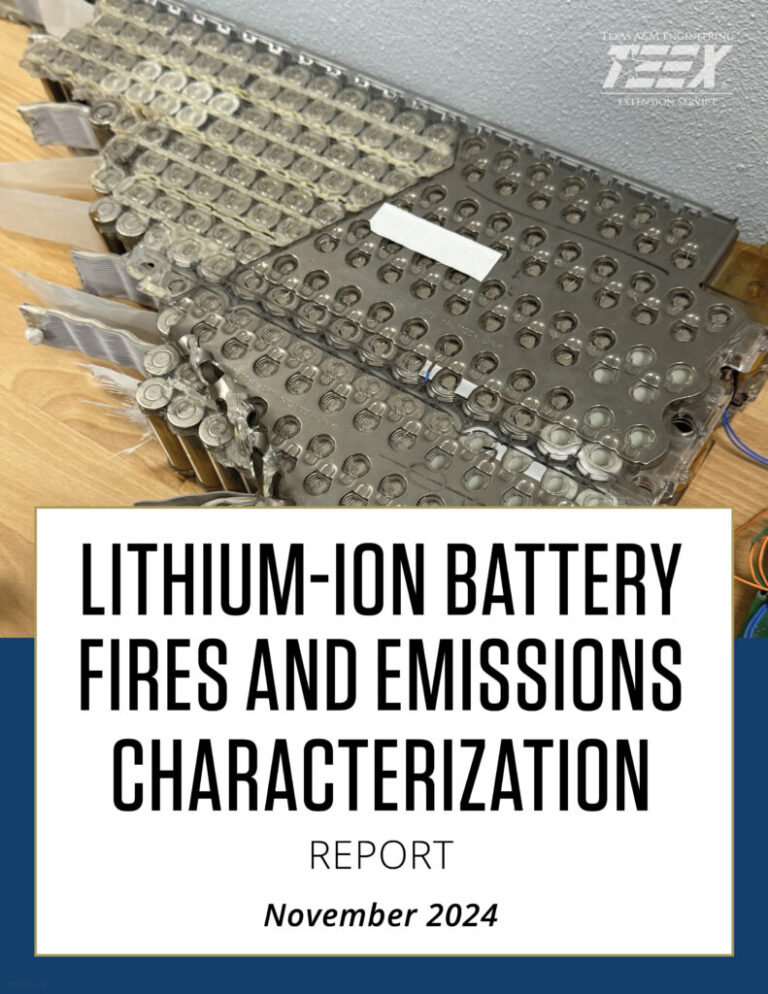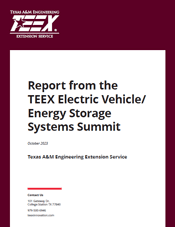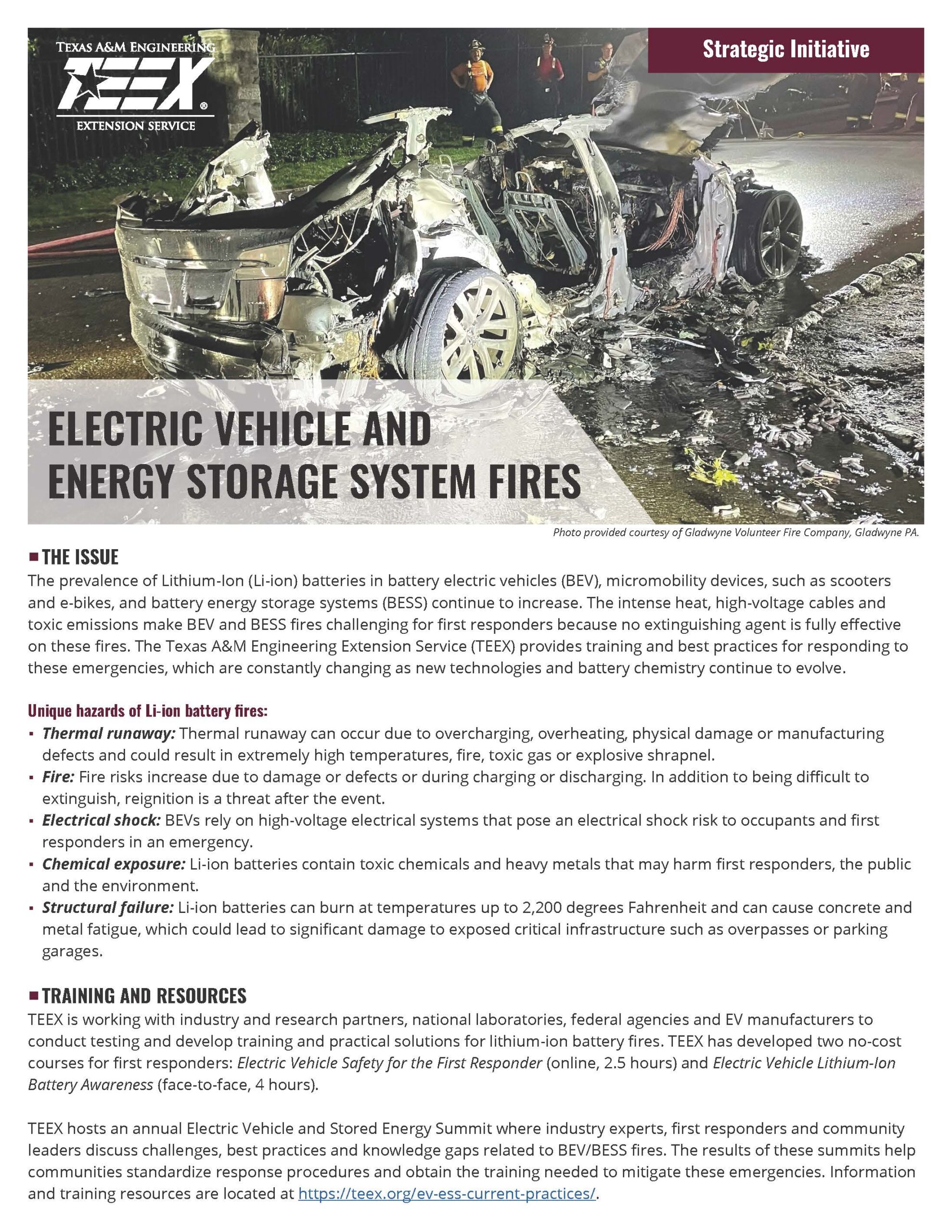Current Practices: Electric Vehicle and Energy Storage Systems
updated: January 2025
Lithium Ion Battery Fires and Emissions Characterization
In May 2024, Texas A&M Engineering Extension Service (TEEX), along with its research partners, conducted a series of tests to determine the contamination produced by lithium-ion (Li-ion) batteries and its impact on first responders and their personal protective equipment (PPE). Researchers also measured the effectiveness of different cleaning methods. All tests were conducted at the Southwest Research Institute (SwRI) facility in San Antonio, Texas, under the direction of Dr. Imad Khalek, Institute Engineer and Principal Investigator.
Li-ion batteries are used in electric vehicles, energy storage systems, scooters, bicycles, hoverboards and other consumer products. During testing, researchers subjected the batteries to thermal runaway by overcharge. The tests were conducted in a blast chamber where bunker gear swatches, apparatus fabric and self-contained breathing apparatus (SCBA) straps (referred to as equipment) were exposed to the byproducts of Li-ion battery fires. The tests measured 24 heavy metals and 75 semi-volatile organic compounds (SVOCs) resulting from the Li-ion battery fires.
Three separate tests were conducted:
- Test 1 exposed bunker gear swatches and equipment to Li-ion battery thermal runaway with an analysis of the chemical and metal particulates in the gear with no cleaning performed.
- Test 2 exposed bunker gear swatches and equipment to Li-ion battery thermal runaway and the bunker gear swatches were cleaned using traditional NFPA 1851 water-based extraction.
- Test 3 exposed bunker gear swatches and equipment to Li-ion battery thermal runaway, and the bunker gear swatches were cleaned using a liquid carbon dioxide (CO2) process.
The tests concluded that:
- Li-ion battery thermal runaway fires are an extreme emissions event, releasing highly toxic gases and particles that exceed the Occupational Safety and Health Administration (OSHA)-permissible exposure limits (PEL).
- During the tests, contamination in the blast chamber was extremely high. It ranged from 12,000 to 17,000 times more than the United States Environmental Protection Agency (EPA) ambient standard of 9 μg/m³ for Particulate Matter (PM). Emissions were dominated by metallic particles and, to a lesser extent, soot.
- High concentrations of lithium, nickel, cobalt, manganese and copper were detected during each Li-ion thermal runaway event, with lithium being the most dominant.
- The traditional NFPA 1851 water-based cleaning of the PPE removed about 99.2% of all the metallic particles in the gear; liquid CO2 cleaning removed 99.8% of all the metallic particles.
- Some of the SVOCs remained in the gear after water-based cleaning. Cleaning efficiencies ranged from 21% to 92%. Liquid CO2-based cleaning was highly effective, with many SVOCs being undetected in the cleaned gear.
- Several metals, such as cobalt, manganese and lithium, remained in the gear regardless of the cleaning method used.
Upcoming Speaking Engagements
National Sports Safety and Security Conference & Exhibition
July 1, 2025
IAFC – Southwest Division Annual Conference
October 22-23, 2025
Cooperative Hazardous Materials Enforcement Development (COHMED) Conference
February 2-6, 2026
EV/Li Fire & Safety Video Series
- Responding to Electric Vehicle Fires
- How are First Responders Handling Electric Vehicle Fires?
- What is the main difference between Internal Combustion Engines and Electric Vehicles?
- How is an Electric Vehicle Fire Different than an Internal Combustion Engine Fire?
- What Triggers an Electric Vehicle Fire (Thermal Runaway)?
- Summary of Why Emergency Stop (E-stop) Buttons Should be at EV Recharging Stations
- Raising Public Awareness Regarding Lithium-ion Batteries
- Understanding Hazards of Lithium-ion Batteries
- First Responder Tips for Lithium-ion Fires
- How First Responders Treat Lithium-ion Fires
- Lithium battery benefits
- How Photovoltaic Energy (Solar) Could Affect First Responders
Resources
Emergency Technical Decon
Liquid CO2 Bunker Gear Cleaning Service
Energy Security Agency (ESA)
- Energy Security Agency serves manufacturers, public/private organizations, first responder communities and end-users with recommendations and training for safe battery handling.
- ESA houses the most extensive library of EV Emergency Response Guides provided by manufacturers.
- Risk Analysis and Guidance for First Responders
- Risk Analysis for Towing and Recovery Professionals
- Telephone: 855-ESA-Safe (855-372-7233)
European Environment Agency (EEA)
Report 13/2018: Electric Vehicles From Life Cycle and Circular Economy Perspectives
EV Rescue- Response Guide application
Apple Store Application: EV Rescue-Electric Vehicles (EVR)
Lithium-Ion and Energy Storage Systems Resources
Fire Safety Research Institute (FSRI)
HazMat and Rescue Training
International Association of Fire Chiefs (IAFC)
Lithium-Ion and Energy Storage Systems Resources

National Fire Protection Agency (NFPA)
Emergency Response Guides from 35+ alternative fuel vehicle manufacturers for free download
National Transportation Safety Board (NTSB)
Report on Safety Risks to Emergency Responders from Lithium-Ion Battery Fires in Electric Vehicles
U.S. Dept. of Energy
Alternative Fuels Data Center – Electric Vehicles in Texas




